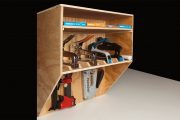(BPT) – As highly fluctuating temperatures become the new seasonal norm, homeowners begin to seek optimal HVAC (Heating, Ventilation, and Air Conditioning) performance ahead of winter conditions.
Many homeowners may be surprised to learn their HVAC system should be inspected yearly, as HVAC maintenance is a crucial to-do in order to maintain efficient heating and cooling, prevent costly breakdowns, and ensure consistent indoor comfort.
Navigating the HVAC industry can be perplexing, with its unfamiliar acronyms and specialized jargon. When homeowners better understand HVAC-industry key words, it aids in confident purchasing decisions, and also helps homeowners to better communicate with contractors.
The following is a list of commonly used HVAC-industry terms that homeowners can benefit from knowing.
1. A2L/Refrigerant: Refrigerant is the liquid used to absorb and transfer heat from one part of the home comfort system to another. It’s important that refrigerant levels be properly maintained — neither too high nor too low. Newer to use within the U.S. air conditioning sector, A2L is a group of refrigerants with a lower toxicity and flammability rating compared to A2 or A3 refrigerants. A2Ls have emerged as a replacement for older, high-impact refrigerants. It is anticipated that A2L refrigerants will be required in 2025.
2. Air Handler: An air handler is the part of an HVAC system that circulates conditioned air throughout the home.
3. Furnace: A furnace heats the inside of a home. It uses natural or liquified petroleum (LP) gas, instead of refrigerant, to heat the air inside the home.
4. BTU: British Thermal Unit. The amount of heat required to raise or lower the temperature of one pound of water by one degree Fahrenheit. Understanding BTU allows homeowners to determine the heating or cooling capacity required to maintain a comfortable indoor temperature, ensuring the HVAC system is adequately sized for the living space.
5. Condensing Unit: Condensing units are found outside of the home. The unit is connected to the indoor unit, either an air conditioner or heat pump, with tubing to carry refrigerant, which is used to transfer heat. To cool your home, a condenser removes heat from indoor air. To heat your home, it brings natural warmth from outdoor air inside your home. A heat pump can also heat your home.
6. Ratings: The higher the following ratings, the more efficient the unit.
- EER2: The updated metric for Energy Efficiency Ratio, formerly known as EER. The ratio of the cooling capacity of the air conditioner or heat pump in BTUs per hour to the total electrical input in watts. This measure is determined by comparing test units to the Air Conditioning and Refrigeration Institute (AHRI) specifications.
- HSPF2: The updated metric for Heating Seasonal Performance Factor, formerly known as HSPF. It measures the efficiency of the heating portion of a heat pump.
- SEER2: The updated metric for Seasonal Energy Efficiency Rating, formerly known as SEER. It is used to express the efficiency of an air conditioner or a heat pump in cooling mode. Similar to miles per gallon in a car, a higher SEER2 number indicates a more efficient unit.
7. Residential Packaged Unit: Equipment in which all heating and cooling components are located in one cabinet. Installed either beside or on top of a home or business.
8. Split System: A home comfort system that uses an indoor and an outdoor component to deliver comfortable air to a living environment. This may involve a combination of elements such as the following: a condensing unit located outside, air handler or furnace positioned indoors. In the case of a system incorporating a gas furnace, an evaporator coil inside the home is also utilized.
9. Stage Systems: HVAC systems designed with various operational stages, including single-stage (on/off), two-stage (two levels of heating or cooling capacity), or multi-stage (variable speed) configurations, enabling them to adjust heating or cooling output to meet comfort preferences while maximizing energy efficiency in diverse conditions.
10. Zone/Zoning: A home may be divided into several different areas, or zones, to better control the temperature. The process of dividing a home into different zones is called zoning.
With basic terminology top of mind, homeowners can seek better optimization of HVAC system performance. Ask questions and gain clarity from trusted contractors. Effective communication with these experts holds the key to precise assessments, improved energy efficiency, and adherence to safety and compliance standards.
Rheem, an innovator in manufacturing HVAC equipment, offers Rheem Pro Partners who are contractors that are well-equipped with resources to provide professional advice and assistance to homeowners throughout the process. Trusted HVAC contractors, like Pro Partners, can ensure customers find the perfect solution for home comfort needs. Additionally, a well-trained contractor should be able to update and inform about cost savings, rebates and energy efficiencies.
It’s not merely about terminology; it’s about increasing the homeowner’s confidence as they create a comfortable, efficient and safe home environment for their family.

